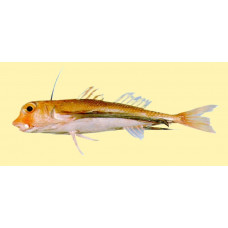Latin name
Dactyloptena peterseni
Other name
Dactyloptena peterseni
Identification
Dactyloptena: Greek, daktylos = fingers + Greek, pten, -enos = wing, fin.
The body of the starry flying gurnard is massive, elongated, almost square in cross-section and tapering towards the tail. It is covered with bony scales that form longitudinal ridges. In the middle of each scale on the sides of the body is a single, transverse, knife-like ridge. The head is large, somewhat flattened dorsoventrally anteriorly; it is enclosed in a bony carapace. The upper jaw is largely hidden by the bones surrounding the eye. The interorbital space is wide, concave; its width is 13-14% of the standard body length. The eyes are large. The mouth is small, semi-low, with tiny kidney-shaped teeth on both jaws. There are teeth on the vomer and palate. There is a long spike in the corner of the premaxilla. The lateral line is absent. The underside of the posterior body has three enlarged keeled scales, the first above the centre of the anal fin; each scale has a strong median ridge.
Features of fish fins
Two dorsal fins, the first with 7 barb rays; the second with 8 soft rays is separated from the first by a deep notch. In front of the first dorsal fin is a free barb on the back of the head; when folded, the end of the barb reaches the second barbed ray in the dorsal fin. The anal fin has 6 soft rays. Caudal fin with a small notch. Pectoral fins with horizontal base, divided into two parts: anterior with five short rays and posterior with 25-26 long rays, the ends of which reach the base of the caudal fin. The pelvic fins have one barbed and 4 soft rays.
Fish colouring
The upper part of the body is dark purple, the lower part is pinkish. There is an elongated black spot in the centre of the pectoral fins.
Distribution
Widespread in the Indo-Pacific from East Africa to Japan and the Bonin Islands, south to Australia, including the Arafura Sea. In Russian waters they are found in Peter the Great Bay and occasionally in Olga Bay.
Habitat
Tropical marine benthic fishes. They live at depths of 50 to 300 metres.
Size
The maximum length of this species is 36 cm.
Behavior
It inhabits the shelf and its edge, on sandy bottoms in coastal areas.
Food and feeding habits
Starry flying gurnards feed on bottom-dwelling crustaceans. They use their pelvic fins to walk along the seabed in search of food.
Reproduction
Nothing is known about the breeding biology of the starry flying gurnard.
Fishing
This species is not commercially important.
Relationship with a person
Harmless. Rarely used for food.
| Classification | |
| Phylum | Chordata |
| Class | Actinopterygii |
| Squad | Syngnathiformes |
| Family | Dactylopteridae |
| Genus | Dactyloptena |
| Species | D. peterseni |
| Features | |
| Conservation status | Least Concern |
| Habitat | Pelagic |
| Life span, years | No information |
| Maximum body weight, kg | No information |
| Maximum length, cm | 36 |
| Sailing speed, m/s | No information |
| Threat to people | Edible |
| Way of eating | Bentophage |
Starry flying gurnard
Tags: starry flying gurnard

